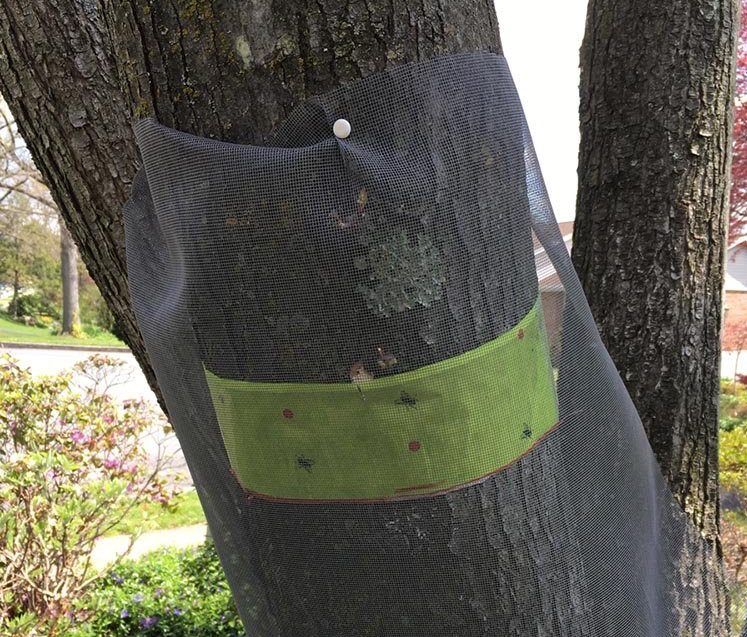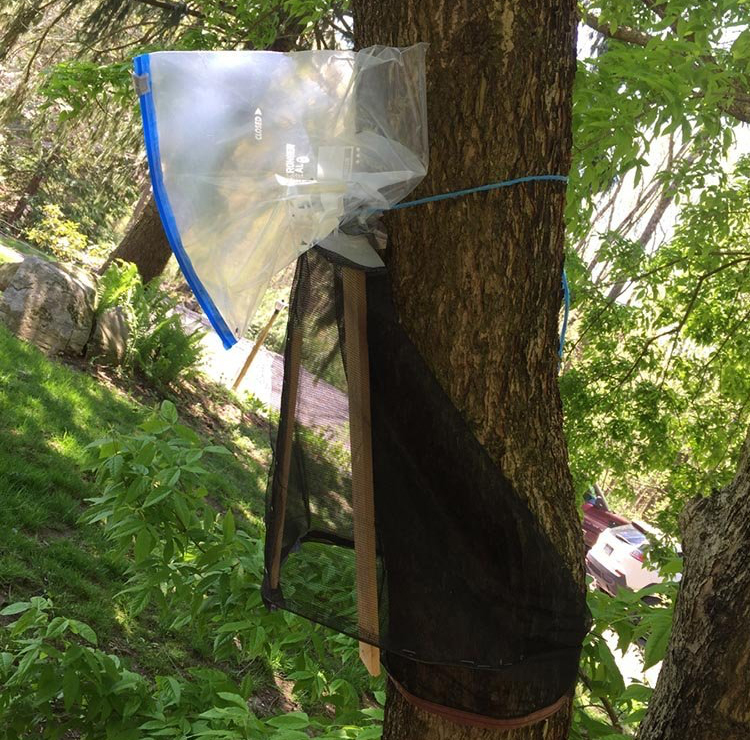Traps can capture and kill SLF on individual trees. Trapping is a mechanical control method that does not use insecticides. You may catch a lot of SLF with a trap, but because they move around in the landscape, trapping will not prevent more SLF from coming to that tree. Also, because we do not yet understand how different amounts of SLF feeding affect the health of specific trees, there is currently no way to determine if trapping SLF will have a significant protective effect.
NOTICE: This method will probably not significantly reduce the greater population of nymphs outside of the trap area, nor will it likely reduce the number of adult SLF you see later in the year.
Traps are used to intercept SLF nymphs and adults as they crawl up the tree trunk. We suggest setting traps as soon as SLF hatch (late April through June). Traps can capture large numbers of nymphs. While adult SLF can also be captured by tree traps, they may avoid them, resulting in less effectiveness later in the season. Two types of traps are often used to capture SLF: sticky bands and a funnel-style trap called a “circle trap.”
Sticky Bands
Sticky bands capture SLF in sticky material as they move up the tree. Several types of sticky bands are available for purchase online or from your local garden center.

Sticky bands have a major drawback: the sticky material can capture other insects and animals, including birds, small mammals, pollinators, butterflies, and more. To reduce the possibility of bycatch, a wildlife barrier of vinyl window screening or other protective material must be installed (above).
Sticky bands deployed without a wildlife barrier are not recommended. A barrier made of chicken wire is not as effective because it can allow beneficial insects and small birds to pass through.
Secure the screening to the tree above the sticky band with pushpins and leave it open at the bottom. It should extend several inches above and below the sticky band and be close to the tree at all points to prevent larger creatures from flying or climbing underneath. If you decide to use sticky bands, check them regularly (every day if possible). If you capture an animal, do not attempt to free it by yourself—you may put the animal and yourself in danger.
If you wish to try to save the animal, cover any exposed sticky material with plastic wrap or tissue paper to reduce additional entanglement, remove the band from the tree as carefully as possible, and take the animal to a wildlife rehabilitation center.
To date, we have not found that any one commercially available sticky band is more effective at catching SLF than another. There is also a commercially available band that uses a white fiber material to hold the inward-facing sticky side of the band away from the trunk of the tree.
This creates a protected sticky surface that reduces the potential of catching birds and other animals. Homemade bands using products like duct tape or petroleum jelly on water-resistant paper are less effective than commercially available sticky bands because they lose their stickiness easily and can allow SLF to escape.
Circle Traps
A circle trap consists of a funnel-shaped piece of screening material that directs SLF into a collection container at the top (Figure 5). Circle traps do not use any sticky material. Much less capture of nontarget insects and animals has been observed in circle traps compared to sticky bands. You can purchase circle traps or build them yourself. For a detailed guide on how to build a circle trap, see this link to PSU Agriculture Extension’s Office on How to Build a New Style Spotted Lanternfly Circle Trap.
Some people have built similar traps devising a range of methods that work. Building these traps is a good project for anyone who wants to kill SLF while saving money by using materials they may already have on hand.

Traps work best on trees with smooth bark; bark with deep grooves may allow SLF to crawl underneath the trap. Place the trap about 4 feet from the ground and secure it tightly against the tree by wrapping the material tightly and using pushpins or staples to attach it to the thickest bark on the tree.
Avoid using nails or anything that would wound the green, living tissue underneath the bark. Only set up traps on trees on your property or where you have permission to do so. Remember to remove all parts of the trap at the end of the season to reduce damage to the bark and eliminate pollution.